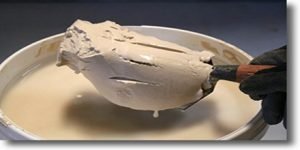Hydraulic cement – Its 6 Types & Uses
A type of cement that hardens and sets very quickly with more water to the finely ground cement is called hydraulic cement. It is the most commonly used cement today.

Nowadays, different usual compounds of modern Portland cement are commercially referred to as hydraulic cement on the market. Containing hydraulic calcium silicates (generally composed of calcium sulfate), It is a non-rusting, non-shrink and non-corrosive, substance widely used in construction projects. It is especially good for structures that are constantly resistant to water because it is impervious to water.
Types of Hydraulic cement
- General Use
- High Early Strength
- Moderate Sulfate Resistance
- High Sulfate Resistance
- Moderate Heat of Hydration
- Low Heat of Hydration

Chemical Composition of Hydraulic Cement
The four components of this cement with the compound.
- Tricalcium aluminate/ Celite (3CaO·Al2O3)
- Brownmillerite (4CaO·Al2O3·Fe2O3)
- Belite (2CaO·SiO2)
- Elite (3CaO·SiO2)

The mechanical properties of this cement are given by the silicates, whereas the last two ingredients are needed for the liquid phase in the production process kiln inside. In addition, certain additives are also needed for special properties such as greatly reduced being used underwater, curing and setting time, preventing shrinking, etc.
When to Use Hydraulic Cement
The right type of cement is to be selected based on the construction work. Various blends of hydraulic cement contain different ratios of chemical components to suit specific requirements.
This cement is highly suitable for projects that require less curing and quick setting time. Although it only gives a short window of time to work with it before it hardens, hydraulic cement is recommended to apply only for projects that can be done in a maximum of 15 minutes with a moderate amount of cement mix prepared a time.
Hydraulic cement’s ability to provide strength is very much, so it can be used to construct highly durable structures. However, cement not flexible, so it can only be used for mechanical support to building structures.
It is not an alternative material For constructing underwater structures. Being impervious to water, hydraulic cement can be used in constructing building structures that are every time contact with water. This type of cement does not rust or corrode, so cement retains its strength even when submerged in water. It is also extremely useful for water-proofing.
Hydraulic Cement Uses
They can be used above of below-grade, although this is extremely useful if used in:
- Maintenance holes
- Sealing around concrete and masonry structures
- Marine applications.
- Chimneys
- Cisterns and fountains
- Swimming Pools
- Drainage systems
- Foundations
- Elevator pits
- Basement walls
How to Apply Hydraulic Cement
It should be applied to surfaces that have been cleaned, dirt, grease, free of oil, or any other contaminant that will not affect the bonding with the permanent building structure. Steps for a successful application.
- Be sure to remove all waste particles before applying them over the surface.
- It is recommended undercutting all areas on which the cement is going to apply.
- According to the ACI, the area to be worked should be saturated 24 hours before the hydraulic cement is used.
- It is important to maintain the temperature of the project area between 45°F (9°C) and 90°F (34°C) during initial curing. Preparation should include enlarging small cracks and avoiding V-shaped cuts and holes.
- Hydraulic cement shall be using a mechanical mixer with rotating blades to ensure a proper mix.
- Pre-wet mixer and remove more water from this mixer.
- Add the water following the manufacturer’s permit and then mix the dry hydraulic cement with others. Do not add water once it begins to set.
- Blend at relatively low speed because properly mix concrete and blend only a small amount of hydraulic cement that can be used within working time.
- Start applying the this cement at the upper portion of the crack, making your way below the portion. Press the paste firmly into the point, maintaining the same amount of pressure until the leak is stopped and cement begins to harden.
- Do not blend excess water as this will cause segregation and bleeding.
11. Do not use any additives or other admixtures.
Hydraulic Cement Pros and Cons
Hydraulic cement will offer some advantages and disadvantages.
- It provides durable repairs that will last for a long life of a time.
- Hardens fast and Sets, generally three minutes after being mixed with water.
- It is a cost-effective solution.
- It is very easy to use in construction.
- Coldwater will retard it, and Hot water will accelerate the setting time.
- It can be applied to vertical applications.
- Hydraulic cement will maintain its strength even if it’s submerged in dry or water.
- Will not become rusted and corrode.
- It will not shrink.
- It can fix leaky pipes and basements without having to stop the leaking.
- It can be painted within one hour of it being applied.
